Review: HTC Vive is virtual reality the way you dreamed it would be
For decades, we’ve been told that virtual reality would one day transport us to alien worlds where we could perform incredible feats we’d only dream of doing in the real world.
We got a taste of that long-promised dream last month, with the release of Facebook’s Oculus Rift virtual reality headset. But as fantastic as the Rift is, there’s still a disconnect between your physical movements in the real world and the game world.
Enter the HTC Vive. Developed jointly by smartphone maker HTC and video game pioneer Valve, the Vive is a virtual reality headset that lets you explore virtual worlds by physically moving in this one.
Take a step to the right in your living room, and you’ll move to the right in virtual space. Jump, and you’ll jump on an alien moon. Duck down, and you’ll dip below a virtual work of art you’ve crafted out of fire.
This is the world of the Vive, and it is everything we were told virtual reality would be. But entering this virtual world has some drawbacks: namely an $800 price tag and the need for a whole lot of free space. So should you enter Vive’s world?
What you’ll need
Before you can even consider it, you’ll need a few things. Chief among them: a high-powered PC. Like the Oculus Rift, the Vive uses your computer to do all the heavy lifting when it comes to generating its virtual environments. In other words, if your PC struggles to run more than a few tabs in your Web browser, you’ll need to upgrade.
HTC and Valve recommend that your PC includes at least an Intel Core i5-4590 or AMD FX 8350 processor, an Nvidia GeForce GTX 970 or AMD Radeon R9 290 graphics card, and 4 GB of RAM. You’ll also need to be running at least Windows 7 or newer; Mac owners need not apply.
To buy a new PC with those kinds of specs, you’ll need to shell out about $1,000. That means you’ll have to drop about $1,800 to use the Vive — not exactly cheap.
The setup
There’s so much gear packed into the Vive’s box it felt like I was pulling open the freaking closet to Narnia. I ripped the box apart as soon as I got my Vive because I’m an impatient man-child, but when I looked around at the mess of wires and connectors at my feet, a cold chill ran down my spine.
This was going to be a nightmare to set up.
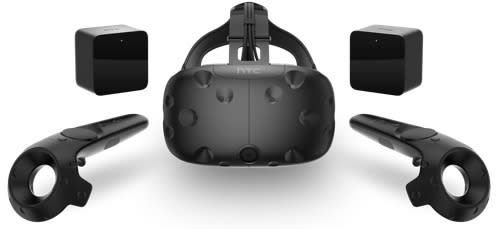
But those initial appearances were deceiving. HTC and Valve have actually made the setup process for the Vive incredibly forgiving. You just have to download and install the Vive’s installation software from HTCVive.com, and it will hold your hand through the entire process.
The one issue you may run into is figuring out where to place the system’s included base stations. In order for the Vive to track your physical movements and then translate those into the virtual world, it uses these base stations to send out lasers that bounce off the Vive’s headset and wireless motion controllers.
The base stations, however, need to either be mounted to your wall, clipped on a shelf, or set up on tripods. The kit comes with wall mounts, but you’ll have to shell out your own cash for a pair of tripods. HTC and Valve recommend that the base stations stand at about 6.5 feet high and create a space at least 6.5 feet by 5 feet for you to move around in. If you live in an apartment, as I do, that kind of room might be hard to come by.
Once you’ve got the base stations set up, you have to trace your play space using one of the included wireless controllers. Doing so allows the Vive to scale your games to the size of the room you’re playing in. After that, you’re ready to jump in.
The hardware
I’ve been playing video games my entire life, and the Vive is on a completely different level from anything I’ve ever experienced. The first time you strap on the headset and pick up the wireless controllers, it genuinely takes your breath away.
The headset itself is fairly heavy, but with a quick adjustment of the straps, it fit around my noggin comfortably. The controllers, on the other hand, feel perfect right out of the box. They’re lightweight but have enough heft to feel substantial when you’re waving them around.
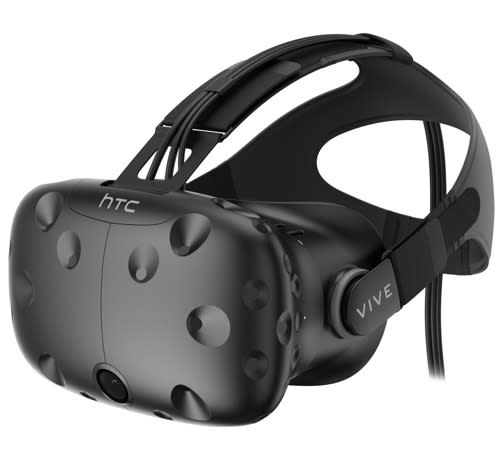
The Vive runs on Valve’s Steam system — the same game distribution platform used by PC gamers around the world. That means you can purchase and browse games, chat with your Steam friends, surf the Web, and look up game reviews on the Vive, just as you would from your desktop PC.
The games
HTC and Valve have bundled three free games with the Vive: Tilt Brush, Fantastic Contraptions, and Job Simulator: The 2050 Archives. Tilt Brush is an art game that allows you to draw in a 3D space using light, fire, rainbows, and more than a dozen other brush styles. This is the game I’ve used to introduce everyone to the Vive, because it’s easy to navigate yet offers an incredible amount of depth.
After 10 minutes with the game, one of my colleagues had drawn a psychedelic landscape, while another spent her time decorating a snowman. What blows everyone away, though, is when I tell them to walk around their creations. It’s then that they realize they’ve been working in a truly 3D world, and their faces light up with sheer joy.

Fantastic Contraption is another game designed to let you explore your creative side with the Vive. The objective is to get a ball of jelly into a larger wall of jelly by building elaborate contraptions out of sticks and makeshift motors.
Job Simulator: The 2050 Archives takes place in a world in which robots have completely replaced humans in the workforce. You, however, have the opportunity to experience what it was like for humans to do things like work as a gourmet chef or an office worker.
Everything about this game is just plain fun. From the cartoon-style gloves that act as your virtual hands, to the way you interact with the robots that populate the world (they look like computer monitors), this game is irreverence incarnate.
When I started playing Job Simulator I did nothing but follow the onscreen prompts that explained how to do my job as an auto mechanic or convenience store clerk. But then I decided to see what would happen if I went off the rails and did whatever I wanted; and that was when the game truly opened up.
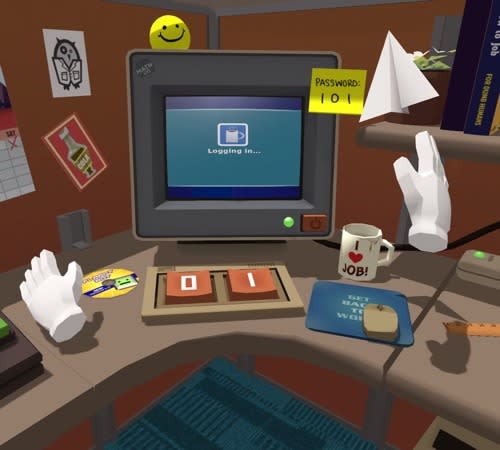
See, you don’t need to give the customer at the convenience store the hot dog they’re asking for. Instead, you can pour a slushy on their head, or jumbo-size a Twinkie, or throw magazines across the store. It’s no exaggeration to say you can do whatever you want with this game. It’s just that much fun.
In Space Pirate Trainer (which is available for purchase through Steam for $15), your Vive’s motion controllers take the shape of space blasters that you use to take down flying drones firing laser beams at you. As they fire at you, though, time slows down, and you can physically dodge those beams. All I could think while playing the game was, “This is what The Matrix must be like.” By the time I was through, I was sweating like crazy from moving so much.
The drawbacks
The Vive is an amazing piece of technology, and it does indeed transport you to new and exciting worlds, but it’s not without its flaws. The long wire that runs down the back of the headset and into your computer can be a tripping hazard. And the fact that you’re moving around but can’t see what’s actually around you can be a bit dangerous.
HTC and Valve have built a special chaperone system into the Vive that pulls up a grid-like screen whenever you get too close to the edge of your pre-set play area, which helps, but that takes you out of the game experience.
You can also enable the Vive’s front-facing camera so you can see what’s going on outside the headset, but you have to be touching the edge of the play area to activate it. At one point, my co-worker walked next to me when I had the headset on, and I couldn’t see her until I reached for the chaperone grid.
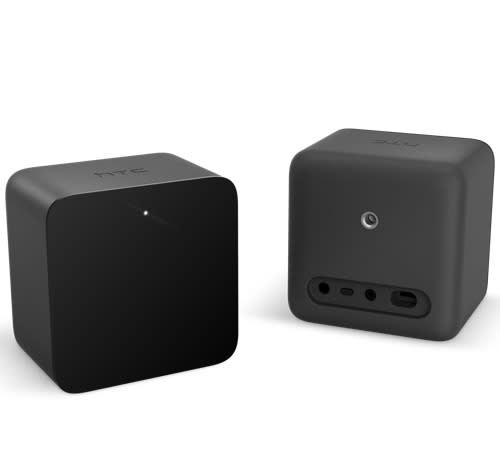
The Vive’s game library also isn’t exactly stellar at this point. Sure, I’ll gush over Tilt Brush, Fantastic Contraption, and Job Simulator, but those aren’t the kind of games that you can play for hours and hours. There just isn’t a killer game for the system yet.
Traveling large distances in games is also a bit wonky. What I love about console and PC games like Fallout, The Witcher, and Call of Duty is the freedom to move over large distances. If I want to waste my time and just run across the world, I can do that.
But because the Vive limits your play space, you can’t do that. Instead, if you want to traverse large distances, you have to use some form of clunky point-and-click teleportation. It’s a Catch-22: To expand your gaming experience, you have to check out of the virtual world.
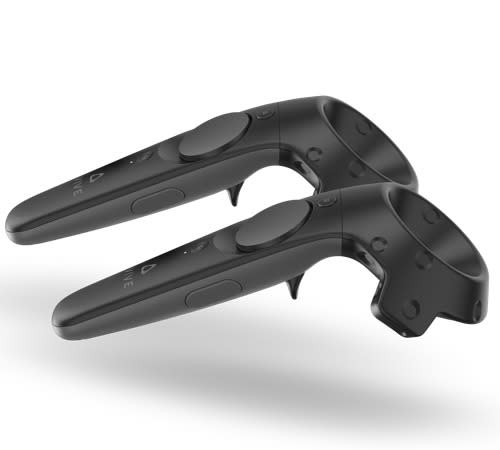
The likely solution to this is to use the Vive’s motion controllers as a traditional gamepad. That wouldn’t be horrible, but it would take away from the main reason you’d buy the Vive: to move around in virtual reality with your own body.
The bottom line
The HTC Vive is an absolutely wonderful piece of technology. Its ability to make you feel as though you’ve left your home and are floating through space or felling enemies with a bow and arrow is unparalleled. Ask anyone who’s used the Vive, and they’ll tell you how absolutely incredible the experience is. It’s flat- out ridiculous fun.
There are some issues, though. Its game library isn’t fantastic yet; its wire can be cumbersome; and its $800 price tag ($1,800 if you need a PC) is high.
If you’ve got the cash and the room in your home, you should absolutely get the Vive. If you’re on the fence, though, wait until the first truly must-have games come out, then decide.
Email Daniel at dhowley@yahoo-inc.com; follow him on Twitter at @DanielHowley.

